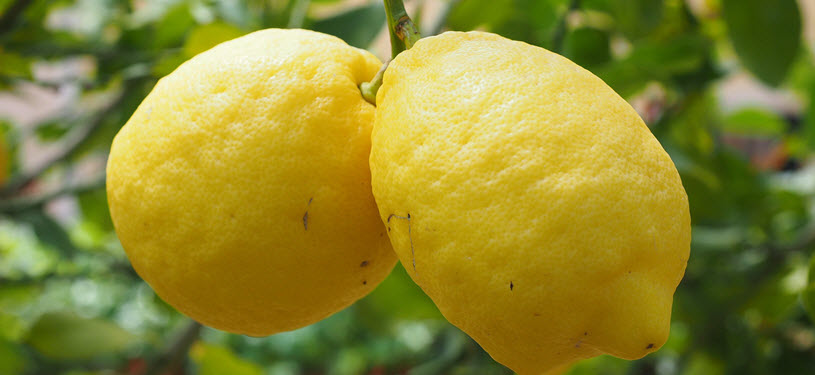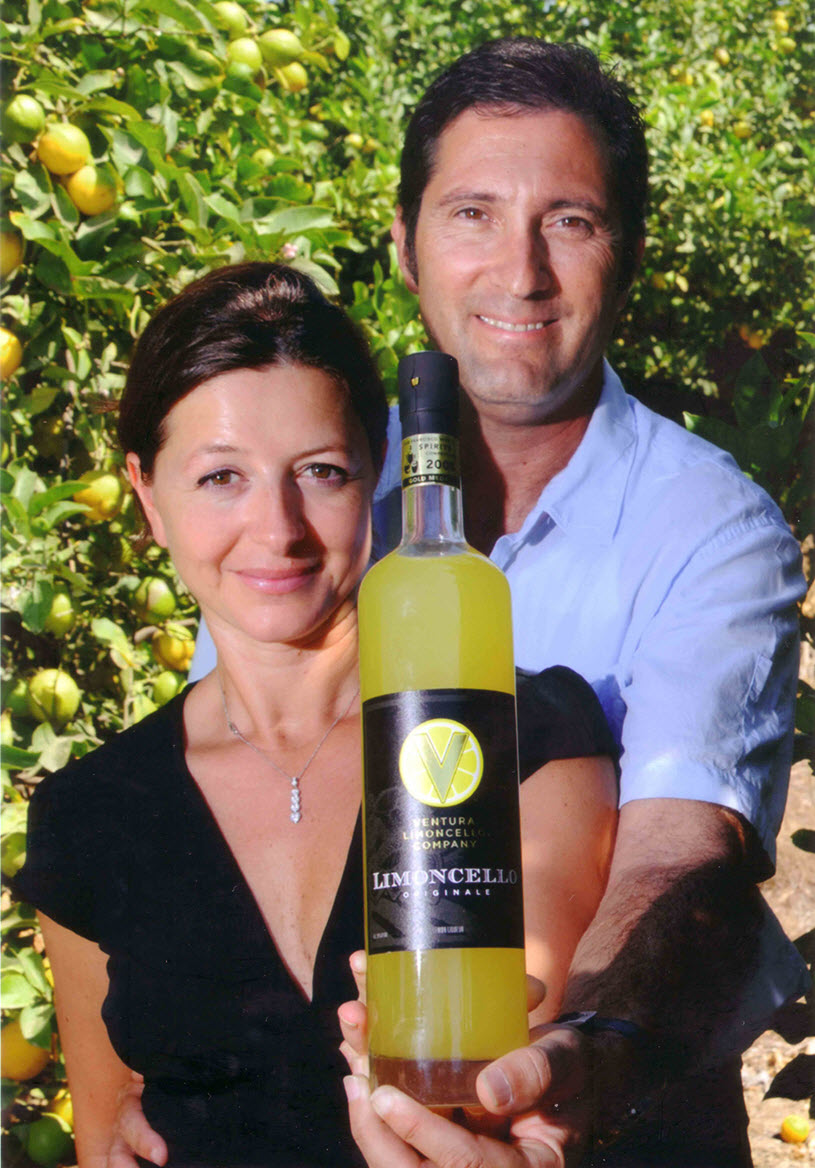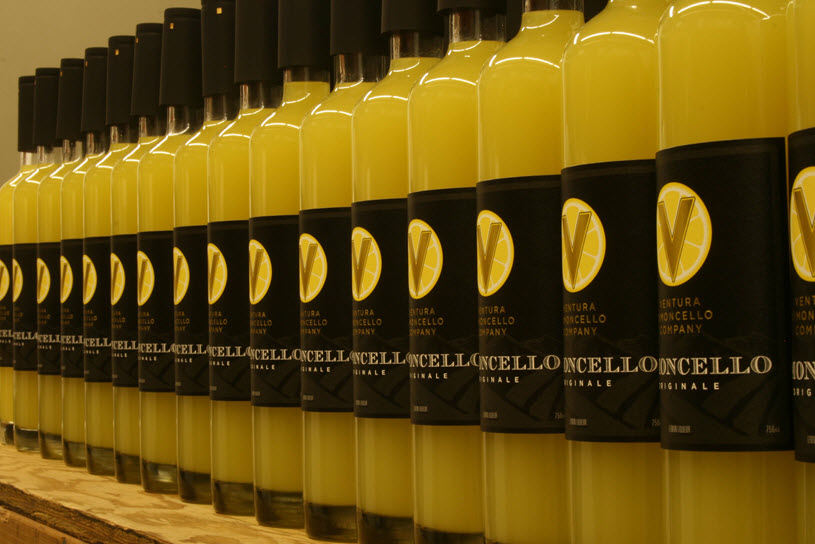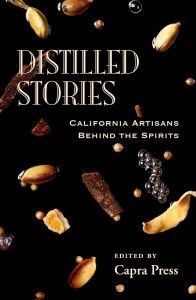
Starting one’s own business is a dream that many people have. It sounds great until you actually try to do it. In the case of starting your own craft spirits distillery, you find not only is the devil in the details but, he’s in your recipe, he’s in your TTB approvals, he’s in your local zoning laws, he’s in your business plan and more. Here’s the tale of how one craft distiller got started.
This start up story is about James and Manuela Carling and their unique limoncello brand – Ventura Limoncello Company. It’s one of several stories as told from the release of the book, Distilled Stories – California Artisans Behind the Spirits from Capra Press. It’s a book that is not so much about brands, but the real people that started the brands and their backstories in their own words, unfiltered. You can get your own copy of the book Distilled Stories here.
The Story of James and Manuela Carling of Ventura Limoncello


Stay Informed: Sign up here for the Distillery Trail free email newsletter and be the first to get all the latest news, trends, job listings and events in your inbox.
In the Beginning…
The first time I heard of limoncello was when my Italian mother-in-law, Rossana, said “You’re lemons are ready, it’s time to make limoncello.” She was referring to the lemons growing on the deck of our townhome in Ventura County, California. She picked the tree bare of the large, ripe fruit and sat at the table meticulously hand-peeling them with a paring knife. If she cut too deep and got “white pith,” she would flip the peel over and scrape it off. The peels were placed in a mason jar with pure alcohol to steep. Several weeks later she returned to mix it all up with sugar water, put it in some rinsed-out bottles and placed them in the freezer. That evening I had my first sip of limoncello and was immediately hooked. We’ve had a bottle in our freezer ever since. That was in 1996.
Being part Italian-American, I was fortunate enough (some would say) to marry into an Italian family. My wife, Manuela Zaretti-Carling, is from Rome, so when I say Italian, I mean “off the boat,” direct from Italy Italian. Many old-country people grow and make a lot of their own foods and beverages. All handed down from their parents, parents, parents, etc. Rosanna learned to make limoncello from her mother, and, like most family recipes, hers was unique in its own way. She was now passing this knowledge on to Manuela, her daughter and my wife, and myself. When our tree bore fruit, we were taught how to meticulously peel the lemons with a paring knife and the family recipe for mixing the limoncello.
We did this at home for several years. When we entertained, we would bring out the limoncello and introduce our friends to our homemade concoction. They all loved it too. Soon, when we were invited to dinner parties, we were asked to bring the limoncello with us instead of wine. I began to think, maybe we had something here.
By the mid-2000s, my career had led me to a senior executive position at The Territory Ahead clothing company in Santa Barbara, California. It was this position which resulted in Manuela and I moving from our townhouse in Westlake Village to the city of Ventura, California. Over twenty years in the publishing and direct marketing (catalog) industry taught me many skills. My expertise was business process management which grew out of positions in information technology, operations, warehousing, inventory control, graphic design and customer service.
Much of what I learned over the years was directly from doing. I’m a hands-on learner. I was also fortunate to have worked under, and with, some strong people over those years. Many mentors shaped my career, especially those who influenced my skills as an executive. Everything I’ve learned from them has applied to what I now do, and along with my wife, Manuela, I make Ventura Limoncello.
“Let’s get a divorce”
In 2006, I felt it was time for a change. There was new management direction at The Territory Ahead, direction that I did not believe in. I shared this with Manuela, and also discussed that maybe instead of seeking another executive position in my field, the time was right to begin a family business, together. We both came from entrepreneurial families and have this in our blood. Her eyes lit up and she said, “Let’s open a restaurant,” I dryly replied, “Let’s get a divorce.” I had zero interest in running a restaurant and in my opinion she would be there twenty hours a day, seven days a week, so we might as well be divorced as I would never see her and would raise our son, James Jr., as a single parent.
To be fair, Manuela is an excellent chef and has dreams of owning her own place. She had worked in several restaurants as well and her parents even at one point owned a restaurant. While she may be really good at it, I was too selfish to sacrifice the time, effort, energy and expense that would be needed to really make it a success. I wanted a family business, together (although our eighteen-year-old son maintains that he has an interest in continuing the family tradition), not a business that she ran and I did something else. Besides, everyone knows most restaurants fail within two years anyway. Her parents’ restaurant didn’t make it and several of her restaurant friends got out when they could. I didn’t understand her logic.
I said, “Let’s make limoncello.” She looked at me like I was crazy. “Are you crazy?” she asked. “Americans don’t know what limoncello is” she added. She was right, I agreed, but I knew that both Manuela and I have really strong marketing knowledge and understand what it means to build a brand. And our brand, Ventura Limoncello, was going to change America’s understanding of limoncello. I pushed this idea and she became lukewarm to it. I began working on the business plan. The night before I was going to inform The Territory Ahead that I was leaving to create my own liquor brand, Manuela looked at me and said, “I’m not ready for this.” And like a good husband is supposed to, I replied, “Yes, dear” and went to the office the next day like any other day.
Ventura Limoncello Is Born
I did not give up on this idea and continued to work on the business plan. There was never a question what our company or brand name was to be: Ventura Limoncello. We were going to make limoncello in Ventura County, the lemon capital of the United States, growing over 80 percent of lemons grown in the entire country. It was the bounty of the county. Where else in the U.S. would we make limoncello? We would have a tasting room and sell Ventura Limoncello to tourists, just like they do along the Amalfi Coast in Italy, the birthplace of limoncello.
I researched all the various licenses that would be required and how long it takes to obtain them. I learned that alcohol is one of the most widely regulated industries in the United States. I visited and spoke to winemakers and modeled our business after them. I didn’t know any craft distillers or distilleries. I researched bottles, caps, labels and companies to source them from. I talked to lemon growers to obtain fresh fruit from their groves. Most of my research was done on the Internet in 2006. Some information was easier found than others. For example, the State of California has good online resources for starting a business. Finding caps and tops was hard. Also, there weren’t many small distilleries in 2006. I didn’t personally know of any, and didn’t find them in my research. In hindsight, always 20–20 they say, I wasn’t asking the right questions, or, in Internet parlance, I wasn’t typing the right search term into Google.
Related Stories
How Craft Distilleries Can Navigate the TTB Compliance & Approval Process
Being a Smart Aleck Cost Distiller Extra 1.5 Months with TTB Approval Process
Looking for a craft spirit products or services? Visit our Supplier Directory
Finding bottles was a real challenge. Did you know that in the USA, you cannot put distilled spirits in a 500 ml bottle? I didn’t and almost bought a whole lot of those. I was going to be making limoncello, not vodka or bourbon. Liqueurs are not consumed at the same rate as other spirits. I felt the 500 ml would be the perfect size. I’m glad I discovered Glass Packaging Solutions. They are wholesale glass brokers out of North Carolina that I finally discovered on the Internet. Bob Lieberman was extremely helpful in listening and guiding us in our search for a liqueur bottle that would meet our needs. He advised me to buy the book Code of Federal Regulations 27: Alcohol, Tobacco and Firearms. Yup, 500 ml is a no-go. Not 250 ml either. You just wonder at the thought process of our federal government regulations sometimes. So we changed our plans to go with 375 ml and 750 ml, known in old-school speak as pints and fifths, respectively.
Danny DeVito: Drunk on The View – “Now is the Time”
In December of 2006, a lightning bolt struck. Danny DeVito, the actor, appeared on the television show “The View.” He was hammered, still drunk after a night of “imbibing limoncello” with his friend George Clooney. “I knew it was the last seven limoncellos that was going to get me.” A lot of Americans just learned what limoncello was and Danny DeVito and George Clooney liked it, a lot. There was a lot of publicity for DeVito, and there was much written about the show and replayed on TV. Great P.R. he has, that DeVito.
Upon hearing this, I told Manuela now is the time. We have to act. Over the next three months we finalized our business plans, calculated costs and prepared. We tried to figure out if we could get to DeVito or Clooney to be our brand’s spokesman (we tried, we couldn’t). In March of 2007, Ventura Limoncello Company LLC was formed and I informed The Territory Ahead I would be leaving.
Not a week later, a close friend showed me an article from that morning’s L.A. Times: Danny DeVito announces he is launching Danny DeVito’s Premium Limoncello next month to the market. What took me over a year he was able to do in three months, sort of. He wasn’t really making his limoncello, he had a company in Italy making it. There was an importer and distributor ready to go, government approvals for bottle and label done. Wait, I got it: It was all planned. It had to be. “The View” was the launch without naming a brand. The awareness of limoncello was just elevated.
Manuela and I did not agree on the meaning of this. She was upset, we’re doomed. I was ecstatic, Danny DeVito was going to raise awareness of our category. It could only help. I began seeking production space and settled on a specific area of Ventura that I believed would be perfect for our operation and tasting and sales room.
Curve Balls
Now the fun really began. I knew how long the various federal and state agencies would take to approve our licenses, labels, etc. and I determined we could get to market by September 2007, in time for the holiday season that year. Provided we found a location by the end of May.
Strike One: No One Wanted Us.
The market hadn’t crashed yet and there was not much available industrial space in our size requirements in the area I was looking. I would drive around, take down numbers off signs and call the realtors. When I explained what we were going to do as a business, they weren’t interested. They didn’t want a distilled spirits plant in their buildings. I was eventually referred to a property group that I was told would be okay with it. Same general area, but not ideal from our standpoint in terms of public access. But they were okay with our plans and we moved into our location in early June 2007, still okay I thought.
Strike Two: City Building Permit.
A big whiff. We needed to make some minor modifications to the space in order to produce our liqueur. Minor is a relative term. To me, minor meant moving a wall seven feet, adding some plumbing and electrical boxes. I drafted some plans (another skill I learned over the years) and began to get quotes from local contractors. Quotes were coming in, and one of the contractors asked if I had acquired the building permit already. Building permit? I thought the contractor would be responsible for that. I was informed that, as the business owner, I would need to pull the permit and was directed to Ventura City Hall. Plans in hand, I went to pull a permit. Not that simple, it seems. I discussed what I needed to do and was handed a Tenant Improvement Handbook. Full architectural drawings would need to be submitted, etc, etc. Ouch. I had to find, interview and hire an architect, submit plans, wait, be denied, get corrections, resubmit, repeat. Long story short: more than three months’ delay and a lot more expense than planned for.
Strike Three: No Tasting Room and No Direct to Consumer Sales?
Our build-out was completed within three weeks (yes, a three-month delay for a three-week project) and we were ready to get our federal and state liquor licenses. It was October, and holiday season 2007 sales were out, but we were progressing. We had our federal inspection and passed. Our Basic Federal Permit was issued in November. We scheduled our California Alcoholic Beverage Control walk-through meeting. One of the walk-through processes is to go over the rules and regulations of the specific license type we were obtaining. In our case, the 07-Recitifer. This, at the time, was an obscure license in California. The local office had never issued one before and not a lot was understood about it. But one thing became very clear: We could not have a tasting room or direct sales. As I mentioned, we modeled our business after limoncello shops along the Amalfi Coast in Italy and wineries in California. Both have the right to produce, taste and sell their products direct to consumers. We didn’t know that in California distilleries did not have this right. We’re nine months in, have a three-year lease, more expense than planned and now no immediate sales or cash flow? That was a big miss in the business plan.
Three strikes, first out, inning not over.
Ventura Limoncello Comes to Market
However, we believed we were going to make a great limoncello and decided to proceed. With all permits in hand, production of Limoncello original began in December 2007 with batch 1207A. We had to learn about our bottling, labeling and sealing machines. We had all our parts ready: glass, labels, capsules, boxes ready to go. Limoncello was mixed and ready to be bottled.
After research, we purchased a four-head bottling machine from X-press Fill, a manual labeler from Race Label and a heat shrink coil from St. Patrick’s of Texas. We tested these items when we received them, but now it was production time. Can’t waste too much product figuring this stuff out when there isn’t much product to begin with. Luckily, we didn’t. Our first batch netted fifteen cases. We continued with the same labeling system for six years, hand-writing on every bottle the exact batch number and the month and the date the lemons were picked. It was important to us to inform our customers of the specific lemon crop that was the source of their limoncello.
Ventura Limoncello was ready to go in February 2008. We started marketing to local stores and restaurants and getting our first sales: Two restaurants and two stores agreed. We were on our way.
Ability to Self-Distribute
In my license-type research, I discovered that the 07-Rectifier had a unique privilege that other distilled spirits licenses did not have: the ability to self-distribute our products to stores and restaurants. While we couldn’t sell direct to consumers, we could still sell. This was critical. We didn’t have to wait to find a distributor that would take a chance on our liqueur. We would sell and deliver ourselves.
At the end of February, we received a brochure in the mail about the 2008 San Francisco world Spirits Competition. That could be fun we thought, and decided we would enter Ventura Limoncello Originale in the Fruit Liqueur category. In March 2008, we received the results via email: Ventura Limoncello Originale was awarded a gold medal. Wow, we felt we made a great limoncello, and now we’ve won a gold medal. Woo hoo! Now we could market and sell Award-winning Ventura Limoncello.
“They were mean to me”
Manuela and I decided we would focus our sales efforts close to home: Ventura County and southern Santa Barbara County. Ventura County is an interesting county that has two unique areas. East county (up the hill) and west county (down the hill). We felt we would divide the turf and she would take east county, being that she already knew some of restaurant owners. I would handle west county and Santa Barbara. We both went out with samples and literature in hand.
Slowly I was making my rounds and getting some orders around town. Some restaurants weren’t interested and hadn’t even heard of limoncello; stores said they didn’t sell a whole lot of “that stuff.” I knew it wasn’t going to be easy, but worked hard to make sure they learned about limoncello and what made Ventura Limoncello unique. Midday, I called Manuela to give her an update on my progress and to see how she was faring in her territory. I could tell she was upset and I asked her what happened. She said that she pitched a restaurant on our limoncello and that they weren’t interested. I replied, “No worries, not everyone is going to buy it.”
“But, they were mean to me.” That was the last day Manuela went on sales calls.
Limoncello Cocktail Culture
Limoncello is a lemon liqueur traditionally produced in Italy and served as an after dinner liqueur. Known as a digestivo (digestive), it is rarely, if ever, used as a mixer there. The term limoncello is like saying “Vodka,” meaning there are different brands. But this is the USA, and selling a limoncello as an after dinner liqueur was proving to be a challenge as we expanded our reach outside of Ventura County. Only Italian restaurants really understood it and many were reluctant to bring in a non-Italian limoncello, even though ours was made by Italians, all natural and, they said, tasted better than the imported ones. American restaurants didn’t know what to do with it. I recall pitching a restaurant and when I told them I was selling Ventura Limoncello, the bar manager said, “We already carry that.” I replied, “No, you don’t have ours. I’m the maker, I would know if you did.” He reached into his cooler and pulled out a bottle of limoncello. It was not Ventura Limoncello but rather Danny DeVito’s limoncello. I spent time explaining to him the differences in limoncello brands and after we taste-tested the two he appreciated the difference. They’ve been a loyal customer for several years now.
We still had challenges reaching new customers and we needed to come up with a new marketing angle. One Sunday morning, I was having breakfast and reading the paper (normal Sunday routine). It was a beautiful spring SoCal morning, so I decided to make a mimosa. Then the light bulb went off: What if I put a splash of Ventura Limoncello instead of orange juice into the sparkling wine? The Limosa was born and was the beginning our new cocktail culture. Limoncello is lemon-flavored, and goes with just about everything. Vodka, gin and tequila, especially flavored vodka. Lemon drops, cosmopolitans, margaritas, hefeweizen beer. We began creating and pushing our limoncello cocktails and opened a whole new market for our brand. Chefs began experimenting with Ventura Limoncello as an ingredient in cooking too.
Growing Pains – Time to Find a Distributor
After three years, I grew the brand to approximately 200 locations throughout Southern California. It was getting more and more difficult for me alone to make our product, then go out and sell it, then deliver it and then finally collect what was due. In addition, due to our awards and Internet presence, our brand was being noticed throughout California and other states. We needed a distributer and found one that appreciated the quality of our product.
Even with a distributer, the truth is, limoncello is a hard sell. We fight every day to be that one limoncello on the bar. As I said before, Manuela was right.
We’re Still Here
We stuck with it and kept plugging away, getting the name Ventura Limoncello out there, entering competitions and getting rave reviews. We are now entering our seventh year on market. Our portfolio now includes three award-winning liqueurs: Ventura Limoncello Originale, Ventura Limoncello Crema and Ventura Orangecello Blood orange. Our liqueurs are currently available in seventeen states with more yet to come.
Ventura Orangecello Blood orange was awarded the 2011 Double gold Medal, Best Fruit Liqueur at the San Francisco world Spirits Competition. It beat our Limoncello Originale that year, which took home another gold in the same category. We continue to look at the bounty of Ventura County to determine where our future will lead us.
Our Last Drinks
- James: California lemon drop with Ventura Limoncello
- Manuela: Negroni with Ventura Orangecello
Please help to support Distillery Trail. Like us onFacebook and Follow us on Twitter.
Ventura Limoncello Originale







